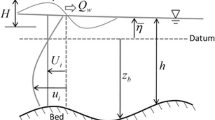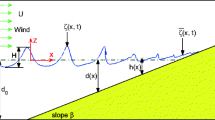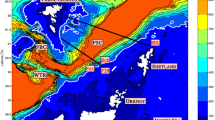Abstract
The boundary layer characteristics beneath waves transforming on a natural beach are affected by both waves and wave-induced currents, and their predictability is more difficult and challenging than for those observed over a seabed of uniform depth. In this research, a first-order boundary layer model is developed to investigate the characteristics of bottom boundary layers in a wave–current coexisting environment beneath shoaling and breaking waves. The main difference between the present modeling approach and previous methods is in the mathematical formulation for the mean horizontal pressure gradient term in the governing equations for the cross-shore wave-induced currents. This term is obtained from the wave-averaged momentum equation, and its magnitude depends on the balance between the wave excess momentum flux gradient and the hydrostatic pressure gradient due to spatial variations in the wave field of propagating waves and mean water level fluctuations. A turbulence closure scheme is used with a modified low Reynolds number k-ε model. The model was validated with two published experimental datasets for normally incident shoaling and breaking waves over a sloping seabed. For shoaling waves, model results agree well with data for the instantaneous velocity profiles, oscillatory wave amplitudes, and mean velocity profiles. For breaking waves, a good agreement is obtained between model and data for the vertical distribution of mean shear stress. In particular, the model reproduced the local onshore mean flow near the bottom beneath shoaling waves, and the vertically decreasing pattern of mean shear stress beneath breaking waves. These successful demonstrations for wave–current bottom boundary layers are attributed to a novel formulation of the mean pressure gradient incorporated in the present model. The proposed new formulation plays an important role in modeling the boundary layer characteristics beneath shoaling and breaking waves, and ensuring that the present model is applicable to nearshore sediment transport and morphology evolution.








Similar content being viewed by others
References
Bakker WT, Van Doorn T (1978) Near-bottom velocities in waves with a current. In: Proc 16th Int Conf Coastal Engineering, ASCE, New York, pp 1394–1413
Bartholdy J, Flemming BW, Ernstsen VB, Winter C, Bartholomä A (2010) Hydraulic roughness over simple subaqueous dunes. Geo Mar Lett 30(1):63–76. doi:10.1007/s00367-009-0153-7
Bertin X, Castelle B, Anfuso G, Ferreira Ó (2008) Improvement of sand activation depth prediction under conditions of oblique wave breaking. Geo Mar Lett 28(2):65–75. doi:10.1007/s00367-007-0090-2
Blondeaux P, Brocchini M, Vittori G (2002) Sea waves and mass transport on a sloping beach. Proc R Soc Lond Series A Math Phys Eng Sci 458:2053–2082
Christoffersen JB, Jonsson IG (1985) Bed friction and dissipation in a combined current and wave motion. Ocean Eng 12:387–423
Cox DT, Kobayashi N (1996) Undertow profiles in the bottom boundary layer under breaking waves. In: Edge BL (ed) Proc 25th Int Conf Coastal Engineering, ASCE, New York, pp 3194–3206
Cox DT, Kobayashi N, Okayasu A (1996) Bed shear stress in the surf zone. J Geophys Res 101:14337–14348
Davies AG, Li Z (1997) Modeling sediment transport beneath regular symmetrical and asymmetrical waves above a plane bed. Cont Shelf Res 17:555–582
Davies AG, Soulsby RL, King HL (1988) A numerical model of the combined wave and current bottom boundary layer. J Geophys Res 93:491–508
Deigaard R, Fredsøe J (1989) Shear stress distribution in dissipative water waves. Coastal Eng 13:357–378
Deigaard R, Mikkelsen MB, Fredsøe J (1991) Measurements of the bed shear stress in a surf zone. Prog Rep 73, ISVA, Technical University of Denmark, Lyngby
Demirbilek Z, Vincent CL (2008) Wave mechanics. In: Coastal Engineering Manual, Part II, Hydrodynamics, Chapter II-1, Engineer Manual 1110-2-1100, US Army Corps of Engineers, Washington, DC
Dohmen-Janssen CM, Hassan WN, Ribberink JS (2001) Mobile-bed effects in oscillatory sheet flow. J Geophys Res 106:27103–27115
Dyhr-Nielsen M, Sorensen T (1970) Sand transport phenomena on coasts with bars. In: Proc 12th Int Conf Coastal Engineering, ASCE, New York, pp 855–866
Faraci C, Foti E, Musumeci RE (2008) Waves plus currents at a right angle: the rippled bed case. J Geophys Res 113:C07018. doi:10.1029/2007JC004468
Foti E, Scandura P (2004) A low Reynolds number k-ε model validated for oscillatory flows over smooth and rough wall. Coastal Eng 51:173–184
Fredsøe J, Deigaard R (1992) Mechanics of coastal sediment transport. World Scientific, Singapore
Fuhrman DR, Fredsøe J, Sumer BM (2009) Bed slope effects on turbulent wave boundary layers: 2. Comparison with skewness, asymmetry, and other effects. J Geophys Res 114:C03025. doi:10.1029/2008JC005053
Grant WD, Madsen OS (1979) Combined wave and current interaction with a rough bottom. J Geophys Res 84:1797–1808
Guizien K, Dohmen-Janssen CM, Vittori G (2003) 1DV bottom boundary layer modeling under combined wave and current: turbulent separation and phase lag effects. J Geophys Res 108:C1. doi:10.1029/2001JC001292
Henderson SM, Allen JS, Newberger PA (2004) Nearshore sandbar migration predicted by an eddy-diffusive boundary layer model. J Geophys Res 109:C06024. doi:10.1029/2003JC002137
Holmedal LE, Myrhaug D (2006) Boundary layer flow and net sediment transport beneath asymmetrical waves. Cont Shelf Res 26:252–268
Holmedal LE, Myrhaug D (2009) Wave-induced steady streaming, mass transport and net sediment transport in rough turbulent ocean bottom boundary layers. Cont Shelf Res 29:911–926
Holmedal LE, Myrhaug D, Rue H (2003) The sea bed boundary layer under random waves plus current. Cont Shelf Res 23:717–750
Holmedal LE, Myrhaug D, Eidsvik KJ (2004) Sediment suspension under sheet flow conditions beneath random waves plus current. Cont Shelf Res 24:2065–2091
Hsu TJ, Elgar S, Guza RT (2006) Wave-induced sediment transport and onshore sandbar migration. Coastal Eng 53:817–824
Kemp PH, Simons RR (1982) The interaction of waves and a turbulent current: waves propagating with the current. J Fluid Mech 116:227–250
Kirkgoz MS (1989) An experimental investigation of plunging breaker boundary layers in the transformation zone. Coastal Eng 13:341–356
Le Roux JP (2008) Profiles of fully developed (Airy) waves in different water depths. Coastal Eng 55:701–703
Le Roux JP, Demirbilek Z, Brodalka M, Flemming BW (2010) WAVECALC: an Excel-VBA spreadsheet to model the characteristics of fully developed waves and their influence on bottom sediments in different water depths. Geo Mar Lett 30(5):549–560. doi:10.1007/s00367-010-0195-x
Li Z, Davies AG (1996) Towards predicting sediment transport in combined wave-current flow. J Waterw Port Coast Ocean Eng 122:157–164
Lin C, Hwung HH (2002) Observation and measurement of the bottom boundary layer flow in the prebreaking zone of shoaling waves. Ocean Eng 29:1479–1502
Lodahl CR, Sumer BM, Fredsøe J (1998) Turbulent combined oscillatory flow and current in a pipe. J Fluid Mech 373:313–349
Longuest-Higgins MS (1953) Mass transport in water waves. Philos Trans R Soc Lond A 245:535–581
Madsen OS (1994) Spectral wave-current bottom boundary layer flows. In: Edge BL (ed) Proc 24th Int Conf Coastal Engineering, ASCE, New York, pp 384–398
Malarkey J, Davies AG (1998) Modeling wave-current interactions in rough turbulent bottom boundary layers. Ocean Eng 25:119–141
Mellor G (2002) Oscillatory bottom boundary layers. J Phys Oceanogr 32:3075–3088
Myrhaug D, Slaattelid OH (1990) A rational approach to wave-current friction coefficients for rough, smooth, and transitional turbulent flow. Coastal Eng 14:265–293
Nwogu GO, Demirbilek Z (2001) BOUSS-2D: a Boussinesq wave model for coastal regions and harbors. Tech Rep ERDC-CHL-TR-01-25, US Army Engineer R&D Center, Vicksburg, MS
Reniers AJHM, Thomton EB, Stanton TP, Roelvink JA (2004) Vertical flow structure during Sandy Duck: observations and modeling. Coastal Eng 51:237–260
Rivero FJ, Arcilla AS (1995) On the vertical distribution of \( \tilde{u}\tilde{w} \). Coastal Eng 25:137–152
Ruessink BG, Kuriyama Y, Reniers AJHM, Roelvink JA, Walstra DJR (2007) Modeling cross-shore sandbar behavior on the timescale of weeks. J Geophys Res 112:F03010. doi:10.1029/2006JF000730
Sana A, Ghumman AR, Tanaka H (2007) Modification of the damping function in the k-ε model to analyze oscillatory boundary layers. Ocean Eng 34:320–326
Schlichting H (2000) Boundary layer theory. Springer, Berlin Heidelberg
Shi JZ, Wang Y (2008) The vertical structure of combined wave-current flow. Ocean Eng 35:174–181
Sleath JFA (1991) Velocities and shear stresses in wave-current flows. J Geophys Res 96:15237–15244
Soulsby RL, Hamm L, Klopman G, Myrhaug D, Simons RR, Thomas GP (1993) Wave-current interaction within and outside the bottom boundary layer. Coastal Eng 21:41–69
Stive MJF, De Vriend HJ (1994) Shear stresses and mean flow in shoaling and breaking waves. In: Edge BL (ed) Proc 24th Int Conf Coastal Engineering, ASCE, New York, pp 594–608
Suntoyo, Tanaka H, Sana A (2008) Characteristics of turbulent boundary layers over a rough bed under saw-tooth waves and its application to sediment transport. Coastal Eng 55:817–824
Svendsen IA (1984) Mass flux and undertow in a surf zone. Coastal Eng 8:345–365
Svendsen IA, Schaffer HA, Hansen JB (1987) The interaction between the undertow and the boundary layer flow on a beach. J Geophys Res 92:11845–11856
Svendsen IA, Qin WK, Ebersole BA (2003) Modeling waves and currents at the LSTF and other laboratory facilities. Coastal Eng 50:19–45
Trowbridge J, Madsen OS (1984) Turbulent wave boundary layers: I. Model formulation and first-order solution. J Geophys Res 89:7987–7997
You ZJ (1994) A simple model for current velocity profiles in combined wave-current flows. Coastal Eng 23:289–304
Zhang C, Wang YG, Zheng JH (2009) Numerical study on vertical structures of undertow inside and outside the surf zone. Acta Oceanol Sin 28:103–111
Zheng JH (2007) Depth-dependent expression of obliquely incident wave induced radiation stress. Progr Nat Sci 17:1067–1073
Zheng JH, Tang Y (2009) Numerical simulation of spatial lag between wave breaking point and location of maximum wave-induced current. China Ocean Eng 23:59–71
Zheng JH, Mase H, Demirbilek Z, Lin L (2008) Implementation and evaluation of alternative wave breaking formulas in a coastal spectral wave model. Ocean Eng 35:1090–1101
Acknowledgements
The work was supported by the National Natural Science Foundation of China (Grant No. 50979033), the Program for New Century Excellent Talents in University of China (NCET-07-0255), and the Special Research Funding of State Key Laboratory of Hydrology-Water Resources and Hydraulic Engineering (Grant No. 2009585812). The authors thank two anonymous reviewers for their valuable comments that have improved the quality of the paper.
Author information
Authors and Affiliations
Corresponding author
Rights and permissions
About this article
Cite this article
Zhang, C., Zheng, J., Wang, Y. et al. Modeling wave–current bottom boundary layers beneath shoaling and breaking waves. Geo-Mar Lett 31, 189–201 (2011). https://doi.org/10.1007/s00367-010-0224-9
Received:
Accepted:
Published:
Issue Date:
DOI: https://doi.org/10.1007/s00367-010-0224-9




